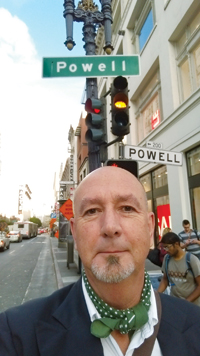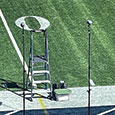 I was never quite teachable enough for either of my parents, a harpist and a violinist in the Bournemouth Symphony Orchestra in England. Each of them wanted, quite naturally, to clone themselves.
I was never quite teachable enough for either of my parents, a harpist and a violinist in the Bournemouth Symphony Orchestra in England. Each of them wanted, quite naturally, to clone themselves.
My father made the first try. He gave me two or three violin lessons, and then his expectations – he had never taught a beginner before – surpassed my abilities. At least with the piano a recognizable musical sound had come out when I pressed a key. The first sounds a student violinist makes are not encouraging.
“Bloody hell!” My dad would expostulate in frustration. Teaching me to fish and ride a bike had been a great deal easier. It felt bad to disappoint my father, but I just wasn’t getting the hang of the violin.
My mother, having experience with the inexperienced, took a more systematic approach to teaching me her instrument. In her worldview, there could be only one way to play the harp: only one way to hold the fingers, take pressure on the string, and release it toward the heel of the hand. After taking up the harp as a schoolgirl in Ireland to escape her hated violin lessons (we had a common bond there), she made her first BBC broadcasts and accompanied some of Ireland’s finest singers on record while still a teenager. Later, at a music college in England, she learned the French style from an Italian teacher. She expressed pity and disdain for harpers from folk traditions who plucked with their nails or clawed at the harp.
“We don’t do it that way,” she would insist, with a wry face. “There’s no sound. Only the correct technique can produce a beautiful tone.”
At the time I had been learning to sing, as a chorister at London’s Westminster Cathedral. Miss Baldock, my teacher, a supremely elegant lady of advanced years, had been a pupil of Enrico Caruso, the global superstar Italian tenor who had been born in the incomprehensibly remote year of 1873. At my first lesson I didn’t even open my mouth; all she taught me was how to stand straight – that is, leaning slightly forward, with my skeleton resting on the balls of my feet, like an athlete poised for action. With this small change in posture I found I could breathe more deeply and sing with less effort. So I could understand my mother’s preoccupation with proper technique as the basis of a fine tone.
By the age of nine I had fallen in love with the magical spirit-sound of Laurie Beers, Principal Flute of the Bournemouth Symphony Orchestra, and wanted to know how to sing through a flute like that. His solo in the Sicilienne (in G minor – the perfect key for the flute) in Fauré’s Pelléas et Mélisande, Op. 80, at one of the orchestra’s regular concerts in Plymouth, captivated my attention. For me, singing in the cathedral – Gregorian chant, Renaissance polyphony, perhaps a crowd-pleasing classical mass at Christmas or Easter – had become just so much everyday work. Once graduated from Miss Baldock’s teaching and consumed by desire to play the flute, I wanted Mr. Beers as my teacher.
I was not to know that Laurie Beers’s sound, like Caruso’s singing technique as I had learned it from Miss Baldock, was an echo from a vanishing world. Beers played a wooden Carte 1867 model flute at a time when the invasive species of silver Lot-style Boehm flutes was displacing all other types in Britain. In place of his centered, steady tone, flutists were adopting the shrill and bleaty sounds increasingly required by the international recording industry. He and a few other British professionals held to the old ways, but the conversion was complete at the school level, where nickel had supplanted silver just as silver was edging out wood in the professional world. Where once Beers had trained for a solid ability to sightread difficult passage work, students were now judged by criteria of tone and inflection, in a style, and a narrow range of modern compositions, all quite foreign to the British heritage. Most were using French-model instruments, originally built to play at a lower pitch, that could not play consistently in tune in a British wind section tuned at A=440. Mr. Beers well knew that both he and his outdated instrument represented a passing style and sensibility. On principle, he refused to pass on his knowledge and taste to students whose careers would be held back by them. And so he would not teach me.
Though I was disappointed, it was just as well I didn’t get to study with a teacher I wanted only to imitate. Instead, my parents entrusted me to a flute teacher willing to do them a favor: John Braddock, another colleague in the Bournemouth orchestra. John played a silver Rudall Carte Boehm flute with a wooden head joint, so he had the best of both worlds. He lived in a big, rambling country house with his wife, who was a cellist in the orchestra and an avid horsewoman, their two sons, and a big smelly hound whose dinner always seemed to be cooking during lessons. He had studied at Kneller Hall, the British military music academy that provided the main route to professional training for wind players in Britain until the mid-20th century. I liked John immensely, and (or because) his teaching was extremely easygoing. The drive to the country, the smells of the dog and his dinners, and my flute lessons all came wrapped into a package that felt like a midweek holiday, or a visit to a favorite and indulgent uncle.
My mother, on the other hand, would overhear me practicing at home, and couldn’t resist intervening in my dreamy pastime. “What are you practicing that for?” she would interject, “You can already play it! Find your weakest point and make it your strongest! That’s the only way to get better! You do want to get better, don’t you?” Harp or flute, she certainly had a firm idea of how things should be done.
Taking her advice meant I soon passed out of the beginner stage, whereupon John patted himself on the back and passed me to David Eaton, the orchestra’s second flutist, a young man eager enough to be an active participant in new music festival seminars in Germany. From him I learned sailing as well as Hindemith, so flute lessons were still far from unalloyed drudgery. At the time I was spending Saturdays with the wind training section of the county youth orchestra, with peers who were mostly far more advanced, under county-employed wind teachers instead of easygoing parental friends. There I learned even more about how to attempt things in ways I hadn’t tried before, to look for my mistakes and evaluate, to search for a way to do it better – in other words, to practice and find ways to improve.
“Start with a passage you can’t play,” one of my coaches suggested, in a tone that was helpful rather than severe. “Break it down into pairs of notes. Play each pair very slowly, until all the fingers are working perfectly in unison with breath and tongue. Then practice each pair fast, with a pause between pairs. Then do the same, except grouping the notes in threes. Then fours. Fives. Then backwards and upside down.” I worked through this routine a couple of times one day, and a few more the next. All at once a section of the Bach E major sonata that had made me break out in a cold sweat began to feel like a pleasure to play. Well, that was a rewarding feeling! I had found a way to dispel my father’s disappointment and my mother’s critical comments – as well as a key to continual improvement in my playing that brought me a renewable sense of satisfaction.
I soon got another chance to put my self-teaching techniques to use. Fred Pain, another ex-military musician, directed the school band from the conductor’s desk (bands play sitting down in southern England), but with a silver cornet in his hand. Mr. Pain played the trumpet too, but rarely. That instrument was in C, while all the band instruments were, like the cornet, in flat keys. Among the B flat and E flat clarinets, saxophones, trombones, euphoniums and tubas, and horns in F, only the flutes were in C. Many of the parts we played – mostly opera overtures and suites popular in the 19th century, when military bands were far more common than symphony orchestras – were written for D flat flutes. Where a nineteenth-century band flutist saw a blank key signature, he (they were all male in those days) fingered in C major; where I saw the same signature, I was playing in seven sharps, a half step higher than written. This meant putting in a lot of extra time, when I might otherwise have been riding my bike or going to the beach, to study the scales of C sharp and D flat, and struggling to transpose a semitone at sight. Though I had no thought of giving up, I felt way out of my depth.
Pretty soon I realized I wouldn’t have to feel this way if I filled a vacant chair in the band for tenor saxophone (in B flat). Although the inventor had cleverly designed this instrument to use essentially the same fingering as the Boehm flute, it played an octave and a second below the written pitch – but at least I could finger the notes as written. Taking up the sax involved learning something new, but by now I knew how to approach learning new things without fear. Feeling as if I had bucked the system but held on to my music, I taught myself to play with nary a lesson. And that is how I became a sax player, without giving up the flute.
After a couple of years of this I moved to a school where there was no need to keep playing the saxophone, but continued flute lessons in pursuit of a final certificate. My new flute teacher, who wasn’t even a flutist, expected something much more like learning by rote. Denis Hartley had studied clarinet at military music school, like John Braddock. He never gave me specific technical instructions or made suggestions on interpretive matters: he saw his job quite simply as getting me through my Grade VIII Associated Board exam, the final, rigorous test in the series of pre-music-college national examinations in Britain.
“E flat minor, melodic, 3 octaves,” he would bark on marching into the studio, and there was no excuse for not knowing by heart this or any of the 24 sets of scales and arpeggios he might call on me to deliver from memory.
Mr. Hartley didn’t need to march me round the drill yard if I fluffed a scale: all he had to do was look at me for the embarrassment of imperfection (I never let it happen more than once or twice) to turn my ears red. Fortunately by now I knew I was the teacher as well as the student. I had at last become teachable, recognizing that the only person who could teach me was me. Any other person in the room was only there to keep me up to the mark, rather as the audience in a concert hall is there to hear the performance.
I went on to apply this insight at university, in postgraduate music studies, in professional concert life, in business, and in scholarship. I still use it when approaching anything new. The teachers who passed on to me how to approach and conquer new difficulties gave me something of value far beyond music: the desire to listen, learn, and apply; to discover and grow. I was lucky enough to have a very unconventional and varied musical training, and to be thwarted in any instinct to simply imitate my teachers. All they taught me was how to check what I was doing against my highest aspirations and work to get closer, day by day, and step by step.






